Air Pollution and the SDGs of Kuwait Student's Name
Added on 2022-03-28
23 Pages5020 Words41 Views
1
Air Pollution and the SDGs of Kuwait
Student's Name
Institutional Affiliation
Course Number and Name
Instructor Name
Due Date
Contents
Air Pollution and the SDGs of Kuwait
Student's Name
Institutional Affiliation
Course Number and Name
Instructor Name
Due Date
Contents
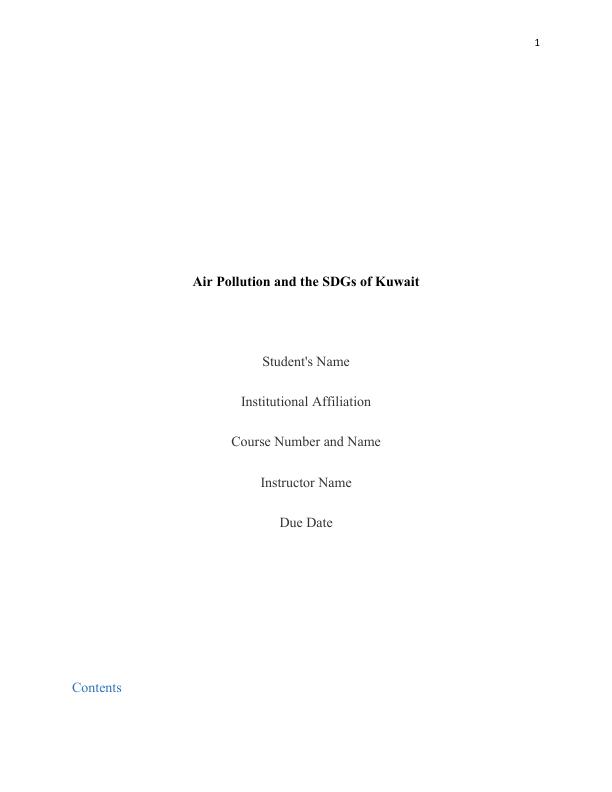
2
1. Introduction............................................................................................3
1.1. Paper Argument...................................................................................4
1.2. Problem Statement..............................................................................4
2. Analysis .................................................................................................8
2.1 Financing Industrialization...................................................................8
2.2 The Connection between Air Pollution and Kuwait’s SDGs ............12
2.2.1 Good Health and Well-being...........................................................12
2.2.2.Sustainable Cities and Communities...............................................13
2.2.3Climate Action.................................................................................15
2.3 Government Social Political and Environmental
Interventions..............................................17
3.Conclusion....................................................................................
.....................................................19
4. List of References.................................................................................21
1. Introduction
1. Introduction............................................................................................3
1.1. Paper Argument...................................................................................4
1.2. Problem Statement..............................................................................4
2. Analysis .................................................................................................8
2.1 Financing Industrialization...................................................................8
2.2 The Connection between Air Pollution and Kuwait’s SDGs ............12
2.2.1 Good Health and Well-being...........................................................12
2.2.2.Sustainable Cities and Communities...............................................13
2.2.3Climate Action.................................................................................15
2.3 Government Social Political and Environmental
Interventions..............................................17
3.Conclusion....................................................................................
.....................................................19
4. List of References.................................................................................21
1. Introduction
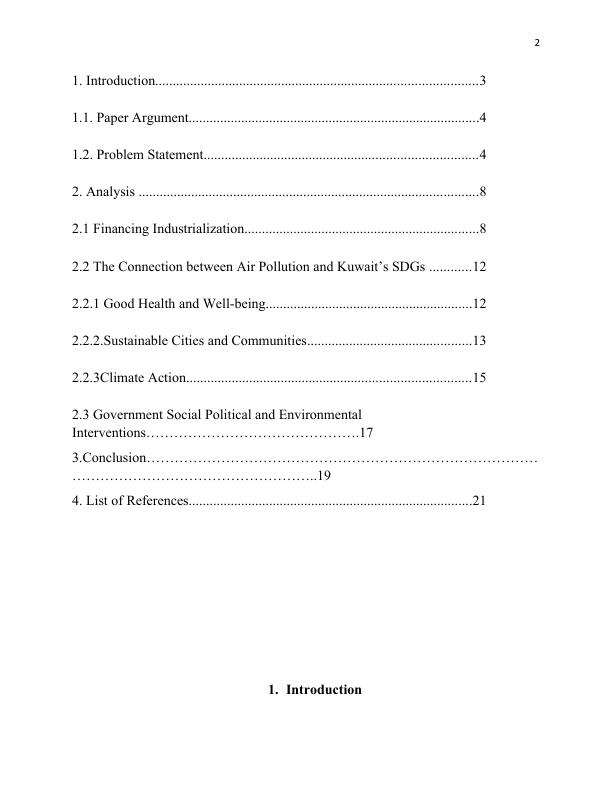
3
The state of Kuwait had achieved important millennium development goals
before adopting the sustainable development goals. The country's rich supply of
natural resources, particularly oil and gas, had made it possible to achieve success
in providing universal education, ending hunger and poverty, and enhancing
gender balance in education and other sectors of society. The country had attained
universal healthcare and made significant social and economic development
(Mohammed & Ali, 2017). In September 2015, the government adopted the SDGs
and undertook decisions aligned with its development plan for vision 2035
(NSDGICK, 2019; Asem & Samira, 2020). Kuwait followed the adoption of the
SDGs with plans, budgets, and a governance structure that engaged the civil
society, the private sector, government entities, and various stakeholders at
institutional and policy levels. The 13th SDG, which is the focus of this study, is
one area that has proven a big challenge for Kuwait, just like its counterparts
across the globe. The challenges posed by climate change have led to global
problems like floods, cyclones, heatwaves, wildfires, droughts, landslides, and
hurricanes.
1.1 Paper Argument
The state of Kuwait had achieved important millennium development goals
before adopting the sustainable development goals. The country's rich supply of
natural resources, particularly oil and gas, had made it possible to achieve success
in providing universal education, ending hunger and poverty, and enhancing
gender balance in education and other sectors of society. The country had attained
universal healthcare and made significant social and economic development
(Mohammed & Ali, 2017). In September 2015, the government adopted the SDGs
and undertook decisions aligned with its development plan for vision 2035
(NSDGICK, 2019; Asem & Samira, 2020). Kuwait followed the adoption of the
SDGs with plans, budgets, and a governance structure that engaged the civil
society, the private sector, government entities, and various stakeholders at
institutional and policy levels. The 13th SDG, which is the focus of this study, is
one area that has proven a big challenge for Kuwait, just like its counterparts
across the globe. The challenges posed by climate change have led to global
problems like floods, cyclones, heatwaves, wildfires, droughts, landslides, and
hurricanes.
1.1 Paper Argument
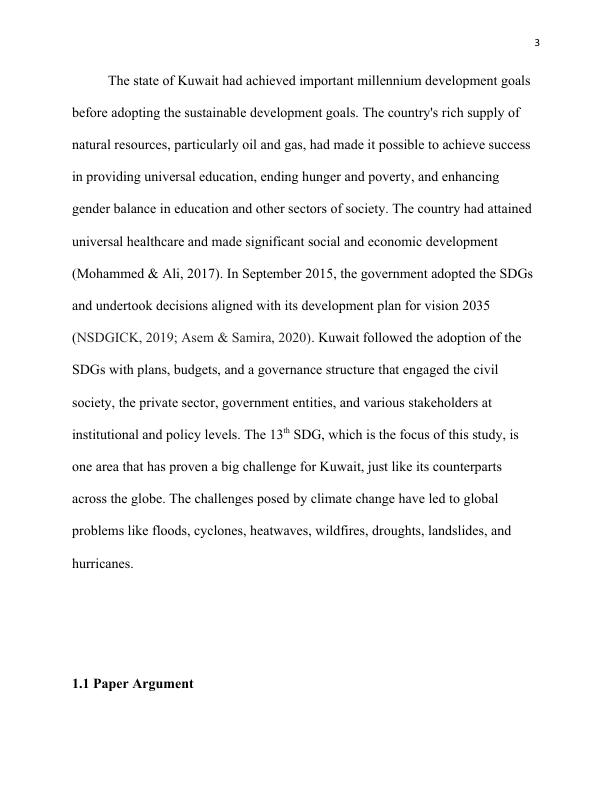
4
Under the five stage model of economic development as proposed by
Rostow, Kuwait falls at the Mass Consumption stage. The economy of this wealthy
nation has undergone progressive industrialization and rapid urbanization leading
to high standards of living for the people (Mohammed & Ali, 2017). With this
stage of development comes various industries leading in durable consumer goods
production adding to new sectors of economic development. This stage of
development has been achieved sequentially following the discovery of fuel and
fossil oil in the gulf region in 1900’s leading to increased revenue for economic
development (Rajan, 2019). This stage however, brings with it serious
environmental conservation challenges as this paper illustrates. These industries
majorly rely on oil and fuel energy for production; subsequently, they use the
transport sector for movement of their products into the market which also rely on
oil and gas. The resultant effect is a serious environmental and air pollution
problem.
1.2 Problem Statement
The specific challenges Kuwait faces due to climate change include;
increased sea levels, loss of biodiversity, desertification, and high temperatures.
The country is regarded as highly vulnerable to policy changes that developed
countries could implement, especially in relation to oil (Asem & Samira, 2020).
For example, climate changes could result in sea level changes that affect aquatic
Under the five stage model of economic development as proposed by
Rostow, Kuwait falls at the Mass Consumption stage. The economy of this wealthy
nation has undergone progressive industrialization and rapid urbanization leading
to high standards of living for the people (Mohammed & Ali, 2017). With this
stage of development comes various industries leading in durable consumer goods
production adding to new sectors of economic development. This stage of
development has been achieved sequentially following the discovery of fuel and
fossil oil in the gulf region in 1900’s leading to increased revenue for economic
development (Rajan, 2019). This stage however, brings with it serious
environmental conservation challenges as this paper illustrates. These industries
majorly rely on oil and fuel energy for production; subsequently, they use the
transport sector for movement of their products into the market which also rely on
oil and gas. The resultant effect is a serious environmental and air pollution
problem.
1.2 Problem Statement
The specific challenges Kuwait faces due to climate change include;
increased sea levels, loss of biodiversity, desertification, and high temperatures.
The country is regarded as highly vulnerable to policy changes that developed
countries could implement, especially in relation to oil (Asem & Samira, 2020).
For example, climate changes could result in sea level changes that affect aquatic
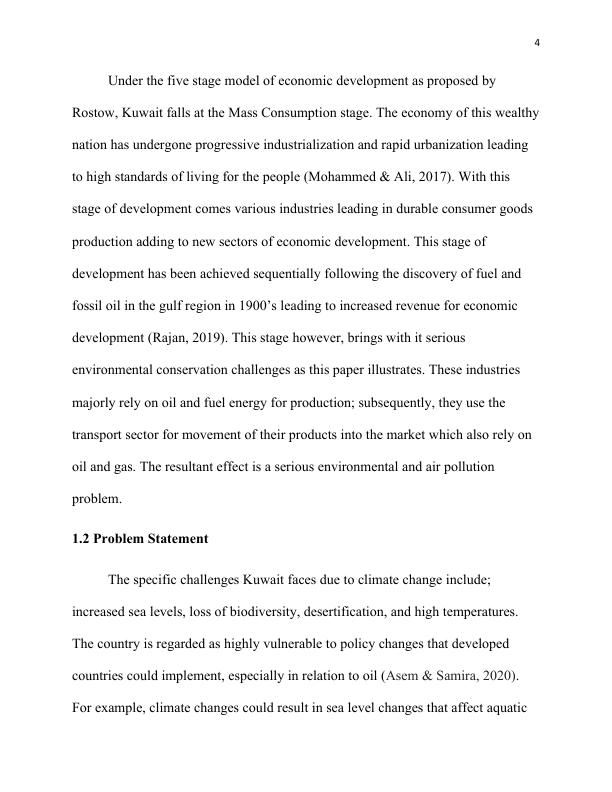
5
life. The country's reliance on oil and gas for economic sustainability means that its
vital threat to achieving effective climate action is the rising CO2 emissions
resulting from air pollution (Achilleos et al., 2019). Kuwait's geographical location
means that problems associated with air pollution could have devastating
consequences if not adequately addressed. Climatic changes resulting from air
pollution will have a long-term effect on the quality of life, health, and well-being
of the people in this country. This paper looks into the air pollution problem for the
government to provide a detailed analysis of the situation.
2. Analysis
The key air quality indicator under the provisions of the World Health
Organization is the concentration of particulate matter (PM). It is the most
common form of air pollution that has implications on both the victims' short-term
and longter health. In the air quality analysis, the specialists use two sizes of
particulate matter, namely, fine particles and coarse particles (Al-Hemoud et al.,
2019). Fine particles have a diameter of 2.5 um or PM2.5. On the other hand,
coarse particles have a diameter of less than 10um or PM10. The small size of
PM2.5 allows the particles to travel deep into the cardiopulmonary system. This
makes it the most concerning as it could result in serious healthcare dilemmas. As
part of the global SDG under the thirteenth goal or objective, health status, age,
season need to be considered when implementing mitigation policies that relate to
life. The country's reliance on oil and gas for economic sustainability means that its
vital threat to achieving effective climate action is the rising CO2 emissions
resulting from air pollution (Achilleos et al., 2019). Kuwait's geographical location
means that problems associated with air pollution could have devastating
consequences if not adequately addressed. Climatic changes resulting from air
pollution will have a long-term effect on the quality of life, health, and well-being
of the people in this country. This paper looks into the air pollution problem for the
government to provide a detailed analysis of the situation.
2. Analysis
The key air quality indicator under the provisions of the World Health
Organization is the concentration of particulate matter (PM). It is the most
common form of air pollution that has implications on both the victims' short-term
and longter health. In the air quality analysis, the specialists use two sizes of
particulate matter, namely, fine particles and coarse particles (Al-Hemoud et al.,
2019). Fine particles have a diameter of 2.5 um or PM2.5. On the other hand,
coarse particles have a diameter of less than 10um or PM10. The small size of
PM2.5 allows the particles to travel deep into the cardiopulmonary system. This
makes it the most concerning as it could result in serious healthcare dilemmas. As
part of the global SDG under the thirteenth goal or objective, health status, age,
season need to be considered when implementing mitigation policies that relate to
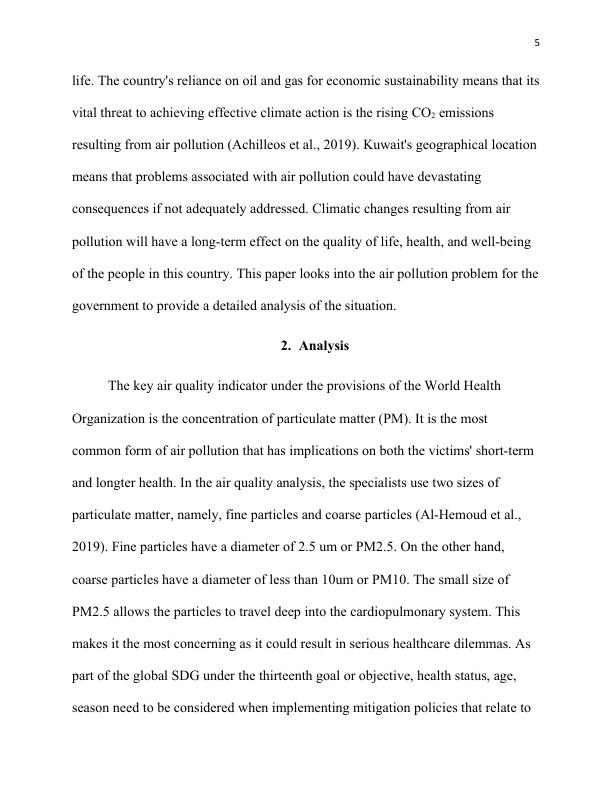
6
air pollution and its destructions (Al-Hemoud et al., 2019; Achilleos et al., 2019).
Like many other countries and cities across the world, Kuwait is significantly
affected by air pollution.
Air quality in Kuwait is not considered safe according to the guidelines of
the World Health Organization. Recent data indicate that the country has an annual
mean concentration of PM2.5 of 61ug/m3, which is much higher than the WHO's
recommendation of 10 ug/m3. The contributors to this poor air quality in the
country include emissions from vehicles and industries, dust storms, and oil
refineries. There is seasonal variation in pollution with higher concentrations
experienced in the winter and the summer (Al-Hemoud et al., 2019). The particular
areas with extremely high levels of air pollution include Saad Al-Jahra and Al-
Ahmadi. The outdoor air pollution in these areas is a mix of chemicals, particulate
matter, and biological elements brought about by the high energy consumption and
poor waste management strategies in oil-related industries. Therefore, people in
these areas are subjected to chronic diseases, premature mortality, breathing
problems, and increased rates of hospitalization.
To put the matter into context, WHO data indicate that the gulf region has
cities with the worst form of air pollution in the world. Experts argue there is a
need for urgent action as the majority of the population in that region depend on
burning solid fuels to meet the energy needs of household (Achilleos et al., 2019).
air pollution and its destructions (Al-Hemoud et al., 2019; Achilleos et al., 2019).
Like many other countries and cities across the world, Kuwait is significantly
affected by air pollution.
Air quality in Kuwait is not considered safe according to the guidelines of
the World Health Organization. Recent data indicate that the country has an annual
mean concentration of PM2.5 of 61ug/m3, which is much higher than the WHO's
recommendation of 10 ug/m3. The contributors to this poor air quality in the
country include emissions from vehicles and industries, dust storms, and oil
refineries. There is seasonal variation in pollution with higher concentrations
experienced in the winter and the summer (Al-Hemoud et al., 2019). The particular
areas with extremely high levels of air pollution include Saad Al-Jahra and Al-
Ahmadi. The outdoor air pollution in these areas is a mix of chemicals, particulate
matter, and biological elements brought about by the high energy consumption and
poor waste management strategies in oil-related industries. Therefore, people in
these areas are subjected to chronic diseases, premature mortality, breathing
problems, and increased rates of hospitalization.
To put the matter into context, WHO data indicate that the gulf region has
cities with the worst form of air pollution in the world. Experts argue there is a
need for urgent action as the majority of the population in that region depend on
burning solid fuels to meet the energy needs of household (Achilleos et al., 2019).
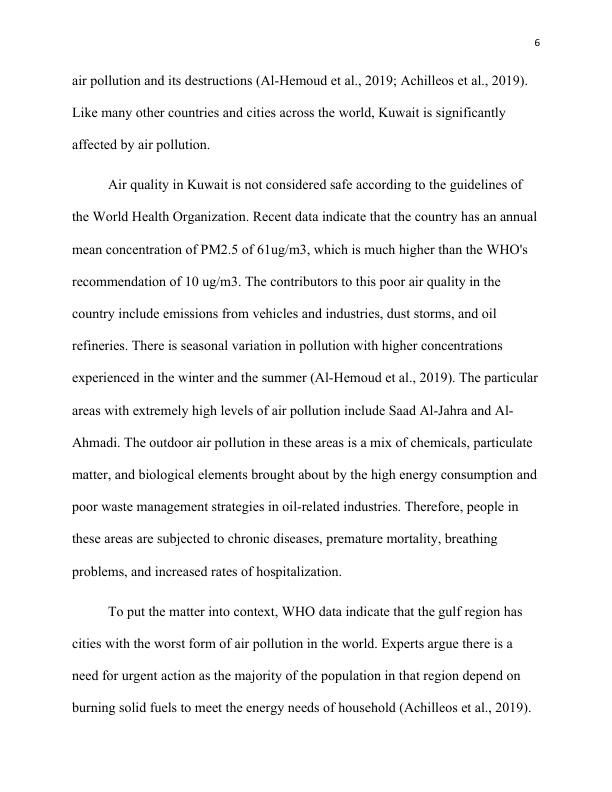
End of preview
Want to access all the pages? Upload your documents or become a member.
Related Documents
UAE’s changing environmental securitylg...
|21
|6362
|116
Assignment on Environmental Sciencelg...
|7
|1625
|88
Environmental Aspects of Oil & Gas Law (ODL)lg...
|18
|3820
|61
Report on Oil and Gas Management and Global Warminglg...
|10
|2300
|37
Human Induced Environmental Challengeslg...
|5
|727
|465
Brief History of Petroleum Industry in Nigerialg...
|44
|11735
|17
